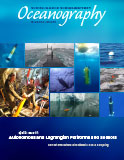First Paragraph
Ocean measurement systems—whether large distributed arrays, moving platforms, or discrete sensors—share a common general limit: the information content of the observations, quantified in terms of the number of octaves of wavenumber and frequency resolved, is roughly proportional to the energy available for the measurements. For example, an octave of resolution in the frequency domain can be added either by doubling the sampling rate of a sensor to better resolve high frequencies, or doubling the sampling duration to add an octave at low frequency. Both involve a doubling of energy, assuming a fixed energy per sample. Similar considerations apply in the wavenumber domain.

